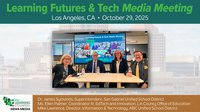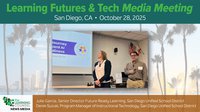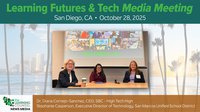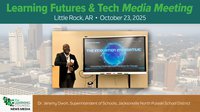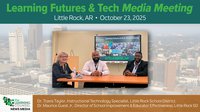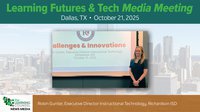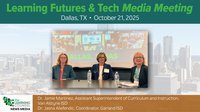The current rate of change in digital learning offers great opportunities and introduces great challenges. The superior learning outcomes and high levels of career-readiness needed to satisfy the demands of 21st century learners and industries require agile educators, learning institutions, and governments and future-proof learning technologies.
Digital learning technologies and methods must produce quantifiable results and must quickly adapt to new requirements and opportunities. At the same time, technologies must be safe and secure and must protect data privacy. Educators, governments, researchers, and technology vendors must leverage modern ecosystem management tools and data analysis to deliver the best-possible on-line safety, learning outcomes, and career readiness.
The digital learning ecosystem is growing at a very rapid scale with hundreds of new EdTech startups created every year. Online SaaS based solutions require a different level of integration within the learner’s access device or the school’s curriculum delivery tools. Teachers and students expect plug-and-play at the enterprise level and single sign-on to everything through their school portal or online browsers, without having to worry about digital safety, online security or data privacy. This is where the open standards such as IMS Global Learning Consortium (http://www.imsglobal.org/), Ed-Fi (https://www.ed-fi.org/), and Access-4-Learning (https://www.a4l.org/) would come in.
We are at the leading edge of a revolution in learning. Fully realizing the potential of digital learning—Building Forward Better—requires new, 21st century tools to manage, secure, and evaluate the effectiveness of digital learning.
Agile Management at Scale: The Key to Effective Digital Learning Technology
Configuring, deploying, and updating learning technology has historically been very much a manual process. Today, manual processes are a bottleneck—they don’t scale. Manual processes are slow, error prone, lack meaningful oversight, create reliability problems, and are impossible to secure.
Agile operation at scale in the 21st century requires modern tools that can:
- instantaneously deploy learning solutions on demand,
- keep those solutions automatically up to date,
- provide safe and secure access to learners and educators,
- protect data privacy,
- analyze the usage and effectiveness of learning technologies, and
- provide for 360-degree oversight and compliance.
Connect Everything: Integration, Automation, and Standards-Driven Innovation
Complete, open integration is the foundation of agility and accountability for a digital learning ecosystem. In the 21st century, FTP, file uploads, manual configuration, and proprietary solutions are distant memories replaced by scalable APIs, workflow automation, secure infrastructure, and industry standards.
Digital learning technology standards such as OneRoster, LTI, Caliper, Open Badges, Ed-Fi, and Common Education Data Standards (CEDS) future-proof the EdTech ecosystem by encouraging interoperability between vendors and engendering a collective ability to adapt to change.
Automated processes move data between standardized interfaces in real-time, keeping applications up-to-date, improving data quality, enhancing security, and reducing operational costs.
A well-integrated EdTech ecosystem is agile, encourages innovations, and readily accommodates change. Standards-based integration and workflow automation help educators deploy and re-configure learning technology on-demand while greatly reducing onboarding and operational costs for learning institutions and technology vendors.
Safety, Security, and Privacy: Protecting Students, Staff, and Institutions
The Internet can be a dangerous place and education technology is not immune. School districts in the United States are under cyber-siege in numbers so large that the Federal Bureau of Investigation issued warnings and investigated incidents.
Learning institutions and solution vendors must keep users safe online, protect user data, and harden digital infrastructure. Steps to providing a safe and secure digital learning ecosystem include:
- properly authenticating end-user and administrative access,
- implementing role-based access policy,
- limiting the sharing of data to essential data elements only, and
- providing the governance and oversight necessary to maintain operational security, comply with laws, regulations, and best practices, and provide the evidence and documentation necessary for security and privacy audits.
Deploying standards-based solutions greatly enhances security because standards are openly reviewed and vetted and are kept up-to-date with current security and privacy requirements. Here is a nice blog that discusses how open standards reduce risks to student data privacy.
Centralized management and governance enhances oversight, streamlines compliance tasks, and accelerates reaction time in the case of a security and privacy event.
Authentication and access control are foundational. Protecting people and resources and enforcing accountability requires knowing precisely who does what, to what, when and from where.
Preparing the Education 4.0 Workforce: Learning Outcomes and Career Readiness
Collectively, everyone involved with digital learning is trying to improve learning outcomes and prepare learners with high levels of academic achievement and career readiness. Learners deserve it. Employers demand it. To those ends, educators and governments want to invest time and money wisely to connect learners with opportunity and industry with a highly qualified, future-proof workforce.
To achieve this goal, educators, researchers, vendors, and governments need accurate data about how digital learning is used and how effective it is. Does it produce the desired learning outcomes? Are those the right outcomes for the 21st century? Are employers satisfied with the skills and career readiness of their candidates and experienced workers?
A well-integrated, connected, digital learning ecosystem collects usage and assessment data from across all digital learning solutions, identifies meaningful patterns, and correlates usage data to learning outcomes and career-readiness goals.
Data-driven digital learning helps the schools, governments, and the EdTech community evolve based upon evidence, respond to change quickly, and invest time and money wisely. Standards, integration, automation and open access to data are the path to effective, agile, future-proof digital learning.
About the author
Robert Iskander is a global business transformation leader passionate about leveraging technology to improve the quality of life for all, with a special focus on K-12 education and was nominated as one of the Top 100 EdTech Influencers in 2017 by EdTech Magazine. Prior to his current role as CEO at GG4L, Robert had several corporate leadership roles over the past 30 years, including General Manager of Sun Microsystems in the Middle East and Global Director of Education at Sun Microsystems (now Oracle). He also ran SchoolMessenger for several years and grew its customer base to 63,000 schools in the US and Canada.




